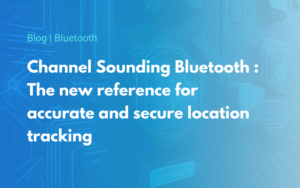How does IoT secure freight transport?
Reading time
Level

The massive development of connected objects and wireless communication technologies is enabling the transport sector to become more digital and offer better security for the transported goods. International trade is expected to grow by about 3.4% per year by 2030, leading to an increase in road traffic. To meet the many security challenges in the transport sector, industry players are increasingly investing in innovative solutions to collect a wide range of data, such as temperature variations, door opening and closing detection, side panel checks, GPS position of trucks, journey time, driver identity and much more. To capture this data, transporters are equipping their vehicles with sensors and beacons that use wireless technologies such as Bluetooth Low Energy (BLE) or LoRaWAN. In concrete terms, how do industrial connected sensors make it possible to secure the transport of goods?
1. IoT applications in transport industry
a. Cold chain traceability
The cold chain traceability is a major challenge for freight transport companies, a challenge that has become even more important since the recent health crisis. Indeed, the transport of the COVID19 vaccine has become the major challenge for transporters in 2021.
To meet this urgent need, IoT players have mobilised to develop easily deployable sensors capable of operating at extremely low temperatures. As vaccines are very sensitive to temperature variations of storage and transport conditions accurate monitoring is essential. The World Health Organisation has stated that almost 50% of vaccine doses worldwide have to be thrown away, partly due to problems with cold chain traceability. This problem also affects the transport of foodstuffs, which represents a large part of refrigerated transport. Sanitary standards are very strict and oblige transporters to equip themselves with certified temperature recorders and to ensure their correct calibration. (Read more about the regulations).
The deployment of IoT solutions to monitor the temperature in truck trailers makes it possible to secure heat-sensitive foodstuffs by being alerted in real time in the event of variations or exceeding of temperature thresholds.
b. Protection of goods against theft
Every year, approximately €8.2 billion worth of goods are stolen in Europe. The cost per carrier is €22,000 on average. To secure their goods, transporters and logistic providers are turning to connected, robust, yet discreet and easy-to-install solutions. To meet this need, IoT integrators offer various solutions, such as detecting the opening and closing of truck doors by magnetic contacts. By positioning a magnetic sensor on the truck door and a magnet on the trailer structure, it is possible to be alerted when the magnet and the sensor are no longer in contact. As this type of sensor can be interfaced with the GPS boxes in the truck cabs, it is very easy to centralise the data history on the transporter’s servers.
c. Truck fleet tracking
The massive development of e-commerce in recent years and the desire of end users to have a precise tracking of their orders, force carriers to equip themselves with truck tracking solutions. By combining different wireless communication technologies such as Bluetooth Low Energy and passive RFID (barcode for example), carriers will be able to know the location of goods and thus provide precise information to their customers.
Bluetooth beacons on truck trailers will identify them as they approach or leave the loading docks. This type of connected object will help to optimise the coupling and uncoupling of trailers by quickly identifying inefficient situations. Finally, the use of GPS beacons operating, for example, with LoRaWAN technology will allow precise monitoring of the truck’s route, the kilometres travelled, the use of trailers and the location where they have been parked.
d. Driver identification
In recent years, the road transport sector has become increasingly digitalized with, among other things, the aim of ensuring the safety of goods, but also of drivers. Indeed, many countries through legislation ensure that each driver and vehicle use an electronic logbook to ensure that driving times and breaks are are adhered to. This is the case in the United States and will be the case in Canada from June 2021. To go even further, some IoT integrators offer solutions that use a badge to identify drivers and enable them to send out an alert in the event of an attack. In addition, this can help optimise vehicle fleets by knowing which driver is driving which truck at any given time.
2. Focus on wireless communication technologies used in transport
a. Bluetooth Low Energy
Bluetooth Low Energy (BLE) is a wireless technology that is very popular with IoT solution integrators because of its low energy consumption, which optimises the life of the beacons and sensors used. Some connected beacons can last up to 20 years depending on how they are used. Added to this, Bluetooth is an open protocol, which makes it very easy to integrate connected objects with a mobile or PC application for data feedback and display. This technology is particularly well suited to the transport sector, as it interfaces with most of the GPS tracker on the market used by transporters. In this case, the telematics box will act as a gateway to upload the data recorded by the sensors and beacons to the client’s servers and IoT application.
If you want to learn more about BLE technology, please read this article.
b. LoRaWAN
LoRaWAN technology is a low-speed, long-range network protocol that can be used on both private and public networks. Telephone operators (Orange and Bouygues in France) provide LoRa antennas, especially in cities, allowing data to be sent over very long distances (several kilometres). This is particularly relevant for the transport sector, where data can be sent back at short intervals. To find out more about how LoRaWAN technology works, click here.
Conclusion
The digitalisation of the road transport sector is driving industry professionals towards solutions that automate a number of tasks, secure goods, vehicles and drivers, but also optimise costs and fleet management.


